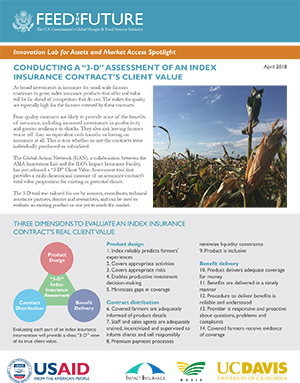
As broad investments in insurance for small-scale farmers continues to grow, index insurance products that offer real value will be far ahead of competitors that do not. The stakes for quality are especially high for the farmers covered by these contracts.
 Poor quality contracts are likely to provide none of the benefits of insurance, including increased investments in productivity and greater resilience to shocks. They also risk leaving farmers worse off than an equivalent cash transfer or having no insurance at all. This is true whether or not the contracts were individually purchased or subsidized.
Poor quality contracts are likely to provide none of the benefits of insurance, including increased investments in productivity and greater resilience to shocks. They also risk leaving farmers worse off than an equivalent cash transfer or having no insurance at all. This is true whether or not the contracts were individually purchased or subsidized.
The Global Action Network (GAN), a collaboration between the AMA Innovation Lab and the ILO’s Impact Insurance Facility, has just released a “3-D” Client Value Assessment tool that provides a multi-dimensional measure of an insurance contract’s total value proposition for existing or potential clients.
The 3-D tool was tailored for use by insurers, consultants, technical assistance partners, donors and researchers, and can be used to evaluate an existing product or one yet to reach the market.
Three Dimensions to Evaluate An Index Insurance Contract’s Real Client Value
Product design
1. Index reliably predicts farmers’ experiences
2. Covers appropriate activities
3. Covers appropriate risks
4. Enables productive investment decision-making
5. Minimizes gaps in coverageContract distribution
6. Covered farmers are adequately informed of product details
7. Staff and sales agents are adequately trained, incentivized and supervised to inform clients and sell responsibly
8. Premium payment processes minimize liquidity constraints
9. Product is inclusiveBenefit delivery
10. Product delivers adequate coverage for money
11. Benefits are delivered in a timely manner
12. Procedure to deliver benefits is reliable and understood
13. Provider is responsive and proactive about questions, problems and complaints
14. Covered farmers receive evidence of coverage
Get started with a “3-D” assessment of an index insurance contract
The GAN “3-D” Client Value Assessment tool merges the AMA Innovation Lab’s calculations for Minimum Quality Standards (MQS) for index insurance with the Facility’s PACE Analysis, adapted for index-based agricultural insurance. The results of the 3-D analysis will highlight gaps and strengths in product design, distribution and delivery, each of which can be used to improve the overall value of an index insurance product.
Good planning is essential for a successful 3-D analysis. Key stakeholders include the insurer, the delivery channel (both managers and field staff or agents) and enrolled farmers. They may also include representatives of a donor supporting the product and consultants or other experts who contributed to product design.
Objectives and deadlines should be discussed with key stakeholders early, along with expectations on activities that require time commitments. The 3-D Client Value Assessment Workplan can help define main steps and timelines, though these can be tailored to each project depending on scope, objectives, constraints and resources.
The success of the analysis will depend on the ability to collect data and to elicit and accentuate honest answers from all stakeholders. At the beginning of the evaluation, identifying who can provide the information needed is essential. The data include:
- Administrative data: Index performance, past yields and product pricing.
- Documentation: Any documentation given to farmers and/or underlying the product, as well as any written training materials.
- External sources: Information obtained from online research, government agencies, interviews with experts, agricultural research institutions, etc.
- Management interviews: Interviews with both head-office management of the insurer and delivery channel on a range of topics that include product design, distribution, claims, staff training and oversight.
- Staff or agent interviews or focus group discussions: Interviews with front-line staff or agents who interact directly with covered farmers, explaining and selling the product to them, completing enrollment, addressing questions or problems and/or facilitating claims.
- Covered farmer interviews: These should capture the perceptions and experiences of a representative sample of covered farmers chosen randomly from the client base from multiple regions, a mix of claimants and non-claimants.
How to apply the results of a 3-D client value analysis
Indicators for which the product obtains poor or average scores are areas where action must be taken to ensure that the product brings value to clients. The information obtained through interviews or additional research typically provides relevant elements to formulate hypotheses on product improvements.
Once the 3-D Analysis is finalized, the insurer and partners may need to prioritize the implementation of recommendations based on scores obtained (prioritizing “poor” scores) and resources available. A written summary or report may also be used as material to communicate the results of the analysis and to obtain the necessary support and resources to implement the recommended changes.
Ultimately, this analysis should inform product improvements and increase client value. The inclusion of the AMA Innovation Lab’s MQS follows one of the key underlying assumptions of this tool: if a product cannot be designed, distributed and delivered to clients in a way that – at a minimum – does not make clients worse off for having purchased the product, it should not be sold.
This report is made possible by the generous support of the American people through the United States Agency for International Development (USAID). The contents are the responsibility of the Feed the Future Innovation Lab for Assets and Market Access at UC Davis and do not necessarily reflect the views of USAID or the United States Government.
